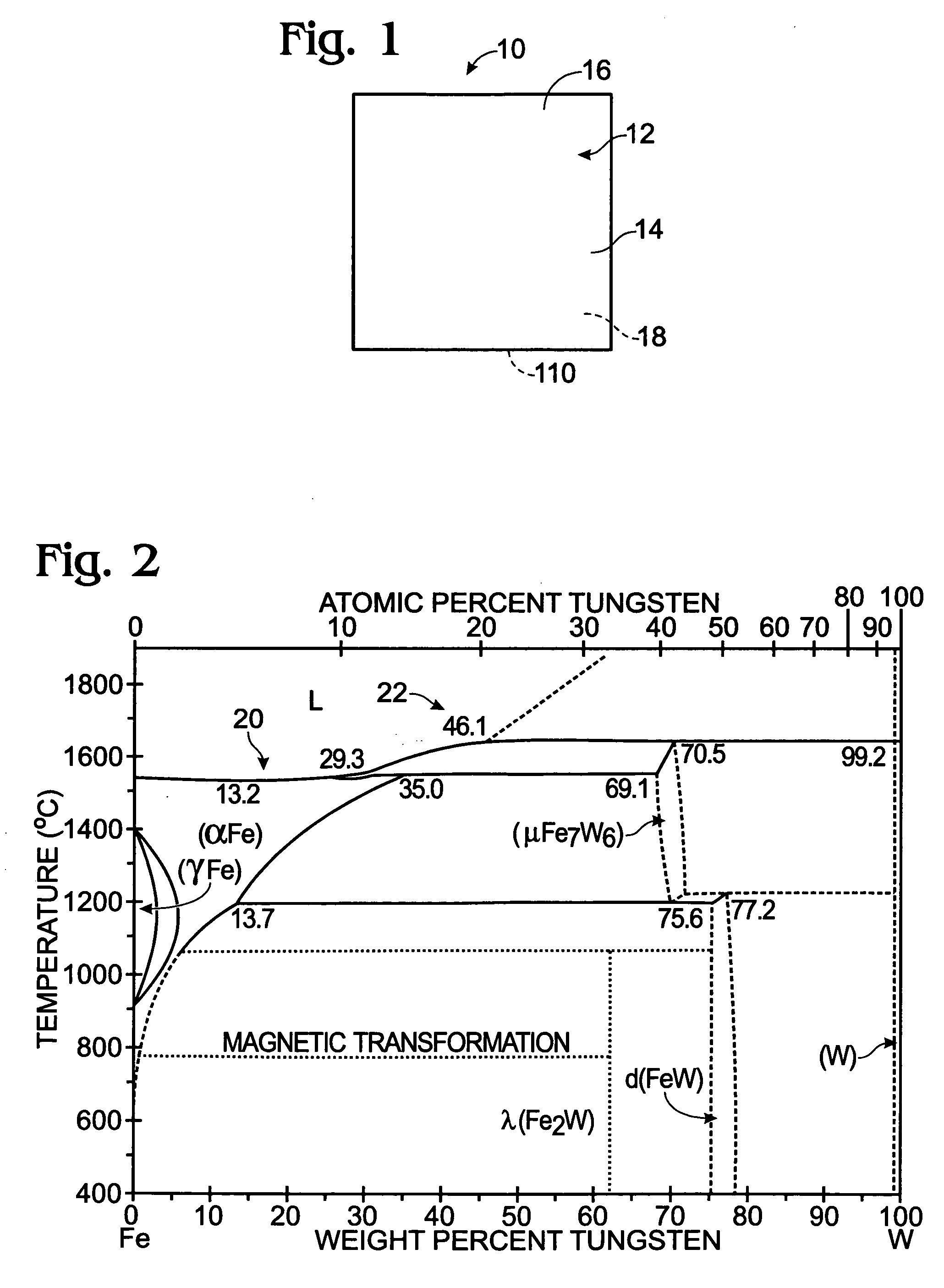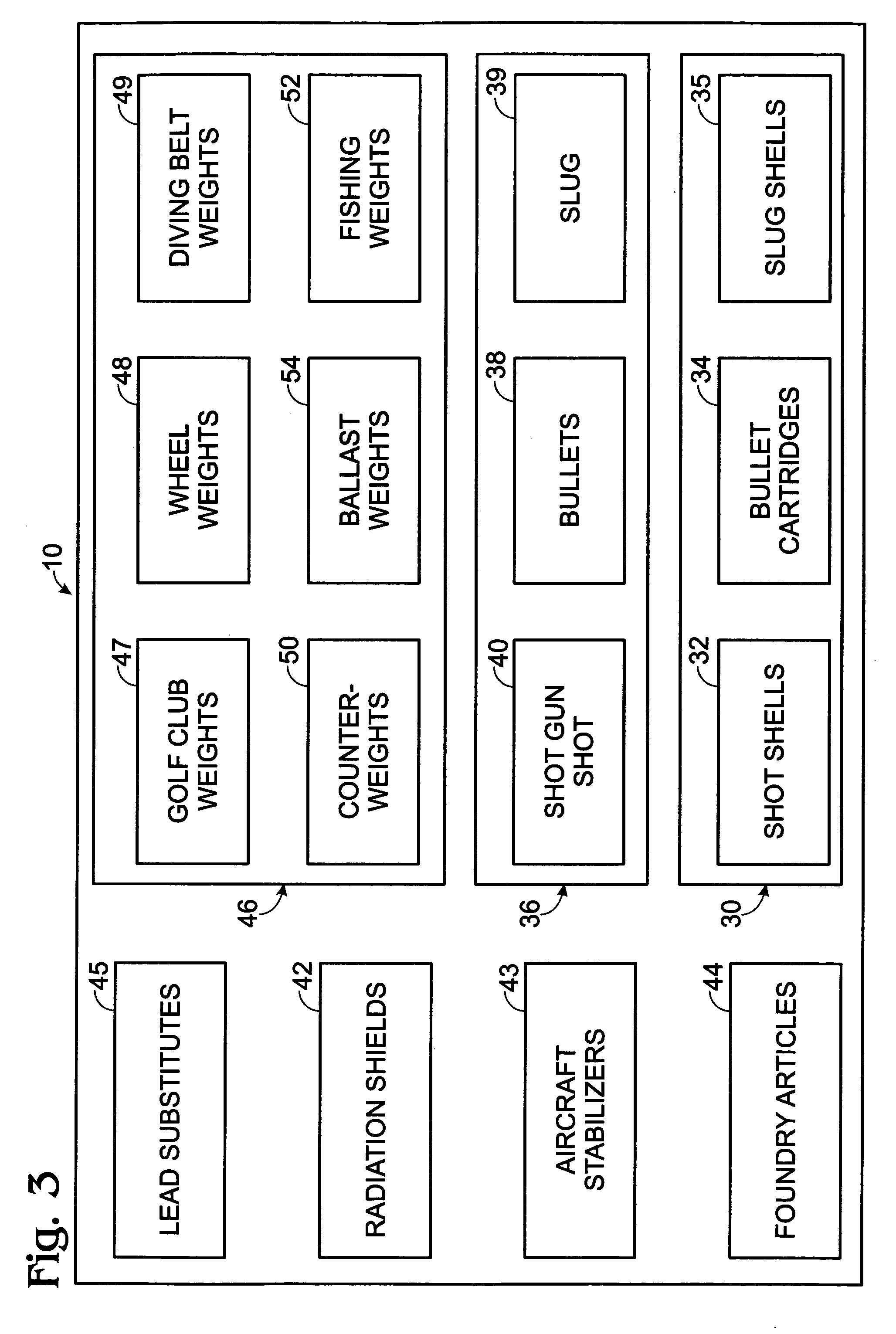Ductile medium-and high-density, non-toxic shot and other articles and method for producing the same
a technology of ductile medium and high density, which is applied in the field of metalic shot, can solve the problems of using any shot material containing more than 1.0%, and materials certainly offer no improvement in ballistic properties over those of steel shot, and achieve the effect of reducing or eliminating damag
- Summary
- Abstract
- Description
- Claims
- Application Information
AI Technical Summary
Benefits of technology
Problems solved by technology
Method used
Image
Examples
example 1
[0079] Vacuum arc-melted (TIG) buttons (100 g each) of three different alloys (Table 1) were prepared using the following input materials:
[0080] Pure W sheet (⅛″ thick) or powder (−325 mesh) Caronyl Ni pellets (⅛″−¼″ diameter) Electrolytic Mn (flakes) Pure Fe (−150 mesh powder)
TABLE 1CompositionsAlloyNi %Mn %Fe %W %12502550 (powder)233.3016.750 (powder)316.716.616.750 (sheet)
[0081] During melting, it was observed that gas evolution occurred on the two buttons with W powder input, while the W sheet used for Alloy 3 did not totally dissolve. Nevertheless, the buttons proved to be ductile as indicated by filing, stamping, and bending by a hammer in a vise. A decision was made to repeat this experiment using a different form of tungsten as input.
example 2
[0082] The alloys of Table 1 (100 g each) were again prepared in the same way, but using−150 mesh ferrotungsten (80 wt % W−20 wt % Fe) instead of pure W. As used herein, all composition percentages should be understood to be expressed as weight percentages. Melting was much improved and complete dissolution of the ferrotungsten was achieved. During melting, it was observed that the Mn-bearing alloy was not as fluid as the other alloys. The alloy buttons were evaluated by performing Rockwell hardness tests on flat-ground areas of the buttons. Table 2 presents these results.
TABLE 2Button HardnessAlloyRockwell B hardness1 A86, 89, 90 (Ave: 88.3)2 A84, 85, 90, 89, 90 (Ave: 87.6)3 A91, 90 (Ave: 90.5)
[0083] In a further variation, ferrotungsten containing 75 wt % tungsten and 25 wt % iron was used.
[0084] Densities were determined by weighing each button and by using water-displacement to estimate its volume. Table 3 presents measured densities for comparison against corresponding value...
example 3
[0089] The following alloys were produced from crushed (−¼ inch) ferrotungsten (76 wt % W), iron scrap (0.08 wt % max. C), carbonyl Ni pellets and electrolytic Mn.
TABLE 4Designed CompositionsAlloyW %Ni %Fe %Mn %A5033.316.70B5030200C503016.73.3D503011.658.35
[0090] Batches of approximately 85 lb were prepared for each alloy, melted in a 100-lb, 150-kw induction furnace, and cast at about 1500-1600° C. into “green sand” molds to produce eight bars of each alloy approximately 1.0-inch diameter by 24 inches long. The cast bars were trimmed, abrasively cleaned and machined. (Portions of the molten alloys were also taken for shot-drop casting and near-net-shape casting which are presented later in Examples 4 and 5.) Table 5 presents chemical compositions (based on actual analyses for tungsten), as-cast Rockwell B hardness, density and results of tests for ferromagnetism.
TABLE 5Actual Compositions and PropertiesDensity,AlloyW %Ni %Fe %Mn %RBMagneticg / ccA48.333.318.4083yes10.8B48.430.021...
PUM
| Property | Measurement | Unit |
|---|---|---|
| density | aaaaa | aaaaa |
| density | aaaaa | aaaaa |
| density | aaaaa | aaaaa |
Abstract
Description
Claims
Application Information
 Login to View More
Login to View More - R&D
- Intellectual Property
- Life Sciences
- Materials
- Tech Scout
- Unparalleled Data Quality
- Higher Quality Content
- 60% Fewer Hallucinations
Browse by: Latest US Patents, China's latest patents, Technical Efficacy Thesaurus, Application Domain, Technology Topic, Popular Technical Reports.
© 2025 PatSnap. All rights reserved.Legal|Privacy policy|Modern Slavery Act Transparency Statement|Sitemap|About US| Contact US: help@patsnap.com



